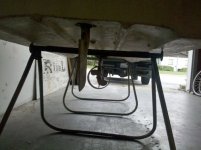Jay64
100 kW
One of the hydroplane boats I picked up is missing the whole rudder setup. So I went to one of the local boat shops to buy a new rudder setup. I was hoping to pick their brain as to what size rudder I would need and some other info about rudders, but they really seemed like your typical parts store employee. Couldn't really give me any info on how to determine my rudder size needs, had a hard time determining what I needed without the part number etc. And I fully admit I am a newbie when it comes to this type of stuff, so I need some help. I tried doing a google search to find the answers, found a few forum questions like this, none of the ones I found had any real answers to my specific question. I did find some info on rudder torque, but a lot of that was based on a known speed and such, but since I am building this boat drive system I don't really have any numbers for speed yet. Should I build it for a desired, hopefully attained speed, and then deal with it at lower speeds until I get to the higher speed? Should I design it for a safe lower speed to test things with, and then as I increase the speed of my boat, change the rudder to compensate for that? I thought there was some way to determine rotor size based on prop size, but I haven't been able to find that info anywhere.
If anyone has any info on this I would greatly appreciate it.
Jay
If anyone has any info on this I would greatly appreciate it.
Jay


